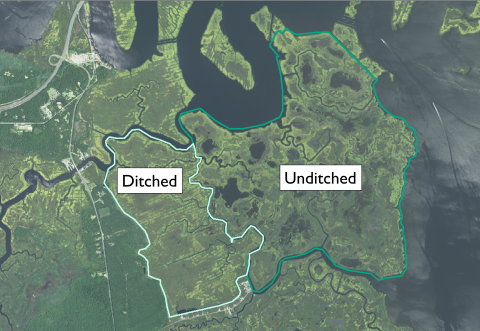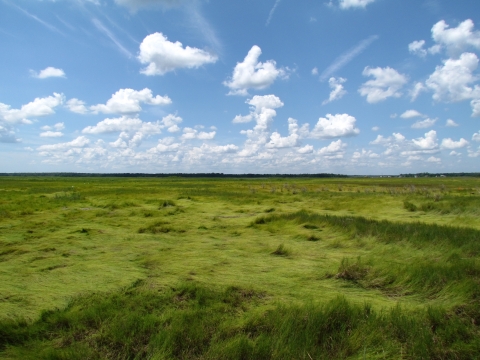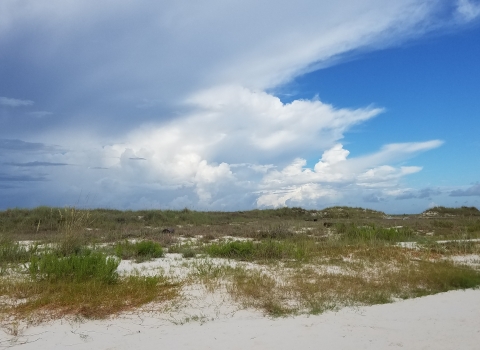The story of most salt marshes across the East Coast is largely the same: Decades of alterations—ditching, flooding, and draining – have left marshes in poor shape, unable to keep up with rising sea levels and provide habitat for local plant and animal species. The same story has played out in the marshes at Edwin B. Forsythe National Wildlife Refuge in New Jersey—except in a small stretch of marsh that seems lost in history, unaltered from its organic trajectory. It tells a different tale.
The 1,600-acre salt marsh salt marsh
Salt marshes are found in tidal areas near the coast, where freshwater mixes with saltwater.
Learn more about salt marsh known as Motts-Mullica Wilderness is truly wilderness—an untouched and un-ditched marsh. At a removed and slightly inaccessible point, the wilderness was never farmed, as the neighboring marshes were. In 1975, the US Congress officially designated the land as such wilderness, under the Wilderness Act. Sitting beside degraded marshland that has felt centuries of human intervention, the Motts-Mullica Wilderness shows an alternate reality—a future that could have been for so many altered marshes, and one that’s still possible if we use restoration techniques that follow nature’s lead.
“This could be a missing link in our understanding of what the needs are for a variety of species,” including black rail and saltmarsh sparrows, said Joe Smith, the wildlife biologist at Forsythe. “It’s the crown jewel of the refuge.”
Rich with “every rare species that would occur in the Northeast,” as Smith explained, the landscape of this marsh can serve as a model for restoring degraded marshes back to resilient systems, with greater biodiversity and stable water flows.
Across the East Coast, salt marshes are experiencing the joint effects of ditching, which interrupts the marshes’ inherent ability to absorb and release water with the tides, and sea level rise, which is drowning the lowest sections of marshland. As the water level shifts, so too does marsh vegetation that is specialized to thrive in different elevations and salinities. Yet, “in this wilderness area wilderness area
Wilderness areas are places untamed by humans. The Wilderness Act of 1964 allows Congress to designate wilderness areas for protection to ensure that America's pristine wild lands will not disappear. Wilderness areas can be part of national wildlife refuges, national parks, national forests or public lands managed by the Bureau of Land Management.
Learn more about wilderness area marsh, it's changed hardly at all,” Smith said.
The differences between the two marshes are distinct.
“The un-ditched marsh has higher high elevations and lower low elevations, whereas the ditched marsh is just kind of flat and average across the whole thing,” Smith said. “There's a lot more diversity in life, bird life, but other things, like insect life and plant life, and then there’s the diversity of the landscape: highs and lows, wet places and dry places.”
Smith explained that the species diversity is linked to the topographical diversity.
“You go from a ridge of higher ground down to a little shallow pool or a mud flat,” he said. “The area is big enough that I can see almost landscape-scale patterns of how creatures are using it.”
Tracking these patterns of how wildlife is using the landscape—and just simply how that landscape itself operates—is exactly the next chapter of land management at Forsythe. Equipped with data that backs up what he is seeing on the ground, Smith wants to use the site to develop guidance on marsh restoration.
Loss of Spartina patens—a high marsh grass that’s losing ground due to sea level rise —is one of the strongest indicators of marsh health. Since 1970, the marshes at Forsythe have experienced a 46% average decrease in Spartina patens via conversion to Spartina alterniflora, a more flood-tolerant species. That decrease varies depending on how close an area is to a ditch, Smith’s findings show. On the ditched marshland immediately next to the wilderness marsh it’s a 24% loss of patens. In the unditched wilderness? It’s zero.
“I want to use this site as guidance on how to try to restore a marsh,” said Smith, who has been studying the waterflow patterns of the intact marsh in the hopes of mimicking them in the deteriorating marshland. “That’s definitely something that I am still trying to understand. How [do you] design that configuration for a place where we really don't have any historic sense of where the channels once were? How do you, essentially, plan the restoration of a whole watershed?”
Answering that question is a bit daunting, especially when human intervention in marshes has a pretty poor success rate, historically: “We have the track record of the past, I just like to acknowledge. [When we look at] everything anyone has done to mashes in the past, no one is happy with it in the present. So how do we break that cycle of being thrilled with ourselves and then regretting it afterwards?” Smith said.
That’s part of why the scene at Forsythe is so incredible: it’s a rare example of historic actions that preserve resilience and biodiversity rather than conquering them. And it’s probably just a fortunate fluke of the past that the “[Motts-Mullica Wilderness is] slightly more isolated. A piece of property the marsh was adjacent to was used for farming. This one's a little bit removed from that and probably just more awkward to get tools and plows to. Maybe that saved it—probably just a historical accident that it escaped,” Smith said. Then duck hunters used the land and likely appreciated its ponds and pockets of water, seeing no need to ditch it. Finally, the Service acquired the wilderness land in 1960 and designated it as such in 1975, formalizing the fate that had previously befallen the landscape by chance through all the years prior. Now, the Motts- Mullica Wilderness will remain wilderness, for all of us to learn from and appreciate in the years to come.





